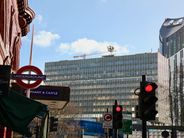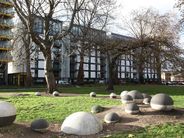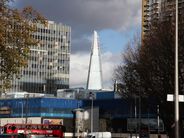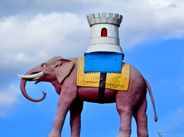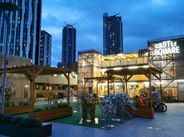
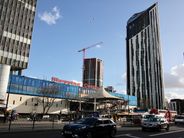
Elephant and Castle
Average sold price last 12 months
£554,443
What it's all about?
When Westminster Bridge was built in 1750, the area was known for its farmland and tentergrounds – where cloth was stretched flat on ‘tenterhooks’ after production. But when the area experienced rapid growth, such as the arrival of the railway, underground and department stores in the late-1800s, it soon became known as the ‘Piccadilly Circus of the South’.
After the area was devastated by the bombs of the First and Second World Wars, it became dominated by the large housing estates of the 1960s and 1970s. The bulk of these buildings have been demolished in the last decade to make way for contemporary developments, featuring public spaces, street food markets and transport infrastructure. With central London, Borough Market and Southbank accessible by foot, bus or bike within half an hour, it’s easy to see why more people are giving ‘the Elephant’ a closer look.
Fact file
- The name is derived from a pub which was named after a ‘cutler’ or knife-maker who’d lived on the site. The coat of arms of the Worshipful Company of Cutlers is an elephant and castle crest, because ivory from elephant tusks was often used on the handles of expensive knives.
- Charlie Chaplin believed he was born in 1889 on East Street, where the market now runs from Tuesdays to Sundays. At the Queen’s Head pub on Black Prince Street (now a café), Chaplin noticed the man who kept the horses there had ‘the most extraordinary pair of trousers I ever saw’. This character became the inspiration for Chaplin’s most famous creation – the Tramp.
Architecture and property
Georgian and Victorian terraced housing can be found throughout the area. The cottages in the West Square conservation area and the historic tenement blocks around St John the Evangelist off Walworth Road also very desirable. A lot of social housing remains, but changes has been accelerating in recent years. The 1960s Ernö Goldfinger-designed Alexander Fleming House was converted 20 years ago into more than 400 flats and renamed Metro Central Heights. In 2007, Strata SE1, the iconic 43-floor black-and-white tower with three wind turbines on its crescent roof, created 400 news homes. More recently, the Elephant and Castle Partnership, a group of public and private organisations, has been coordinating 19 development projects. This has created more than 5,000 new and replacement homes in new towers and blocks and renovations of existing buildings.
For house price information, please visit our resource centre.
Going out
Eating and drinking: Even before the massive regeneration now taking place, Elephant already had a plethora of dining options. Toulouse Lautrec is a French restaurant with a jazz bar upstairs – perfect for a post-meal glass of wine. Try The Beehive’s fish and chips for an honest pub supper, or head to The Old Red Lion, which does food, drink and service to a similarly high standard. For Chinese, the Dragon Castle is still hard to beat, especially for its roast pork puffs. There is a wave of new eateries springing up to cater for the new residents. Mercato Metropolitano, the vast disused warehouse turned street food hall, is the place to be. You could linger all day enjoying the wide range of food and drink on offer.
Local highlights
- The Cinema Museum is sited in the one-time Lambeth Workhouse where Charlie Chaplin lived as a child. The museum houses a fascinating collection of film-related artefacts and memorabilia.
- The Imperial War Museum, although a national institution, is just 10 minutes’ walk from the Elephant.
- The Ministry of Sound, housed in a former bus garage, remains a must-visit for any serious clubber. Underneath the railway arches sits Corsica Studios. Alongside hosting club nights, it also develops underused urban spaces around the capital for use as arts venues.
Green spaces
Although the only large green space is the one surrounding the Imperial War Museum, there are many squares and smaller parks in the area. This includes Pasley Park, Faraday Gardens, Nursery Row Park and the newly created Elephant Park near the train station. In addition, 1,200 trees are due to be planted over the next five years to turn the area from grey to green. A ten-minute bike ride will get you to the much larger Burgess Park to the south, and Kennington Park to the south east.
Transport
Rail: Elephant and Castle is extremely well-connected. The train station runs Southeastern and Thameslink services to London Blackfriars and on to St Albans, and southwards to Sevenoaks, Orpington and Sutton.
Tube: The Bakerloo line starts at Elephant and Castle (you’ll always get a seat in the morning), and the Northern line passes through on its way to the City.
Bus: There are an impressive 38 bus services terminating or running through Elephant, and numerous bus lanes keep them moving.
Road: Although some roads are one-way or bus only, driving is now calmer than was with a new roundabout.
Cycle: The roundabout has been replaced by a two-way road system with separate cycle lanes, allowing cyclists to pass through the area more comfortably.
Getting away: Eurostar services from St Pancras International are 18 minutes away by train, while Heathrow is just 50 minutes via the Heathrow Express from Paddington. Gatwick is about 50 minutes away via the Gatwick Express from Victoria.
Education
There are over 20 primary and secondary schools and academies in the area. Charlotte Sharman Primary School on West Square is a popular local choice alongside St Jude’s Church of England Primary School, which styles itself as a ‘village school in the heart of London’. Ark Globe Academy encompasses primary, secondary and sixth form levels. Of the secondaries, Notre Dame Roman Catholic Girls’ School is well-regarded.
Please see our education resource for more information on schools in this area.
Pop into your nearest KFH branch to talk to our local experts.
Find a property
Looking for a property valuation?
Get an accurate, no-obligation valuation from our local experts.
